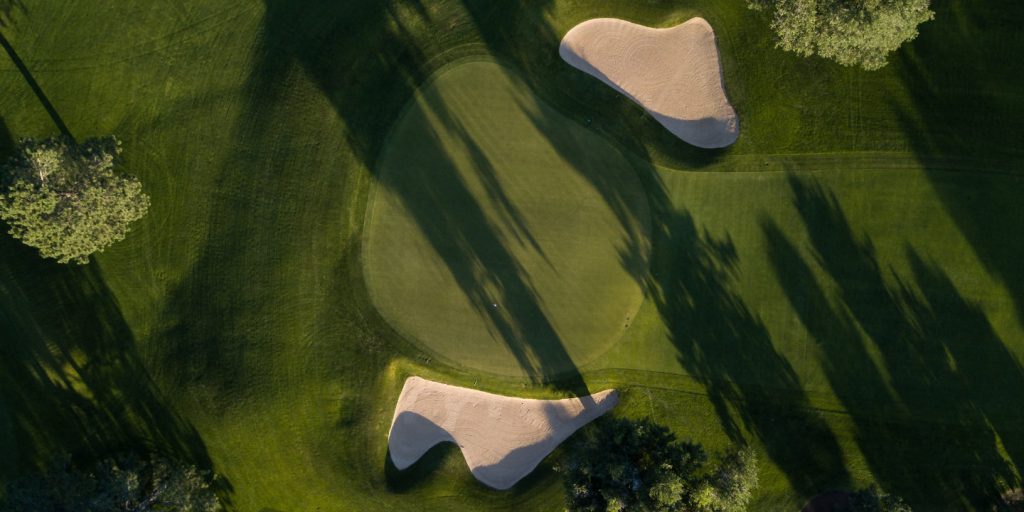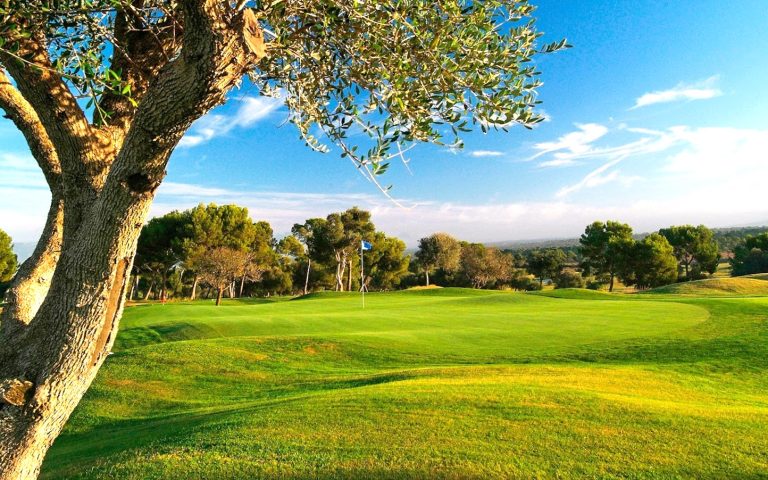Table of Contents
Nestled in the south of the beautiful Spanish island of Mallorca lies Golf Maioris, an immaculately maintained 18-hole championship course that offers golfers a challenging yet enjoyable round of golf.
Built in 2006, Golf Maioris features a traditional parkland layout set against the scenic backdrop of the Mallorcan countryside. Its strategic bunkering, undulating greens, and variety of par 3s, 4s and 5s provide a test for golfers of all abilities.
Course Overview

Designed by renowned golf course architects RS Group, Golf Maioris stretches to over 6,300 meters from the back tees with a par of 72. The front nine holes are reminiscent of traditional Scottish links courses, with rumpled fairways and tricky greens. The back nine then transitions into a more modern American-style layout with water hazards and dog legs coming into play. Golf carts are available to rent for those who want to save their legs.
Amenities and Facilities

The impressive clubhouse at Golf Maioris boasts panoramic views over the course and surrounding countryside. Inside, golfers will find locker rooms, a well-stocked pro shop, and the T19 Restobar restaurant which serves up Mediterranean cuisine on its terrace overlooking the golf course. The practice facilities are also excellent, with a double-ended driving range, chipping and putting greens, and a useful short game area. Club and trolley rental, lessons, and other services are all available on-site.
Course Layout and Design
The front nine at Golf Maioris starts off relatively flat, with wide fairways and few forced carries over water. The par-3 3rd hole features a tricky sloped green, while the dog-leg par-5 4th will reward accurate positional play. Things get more challenging on the back nine, which kicks off with the signature par-3 10th playing across a picturesque lake. The closing holes climb up over gently rolling terrain, placing a premium on carefully judged approach shots to elevated greens that are heavily protected by bunkers.
Playing Experience
Playing Golf Maioris is an enjoyable experience from start to finish. The course has a lovely relaxed vibe and the pace of play is excellent. While the gently undulating greens are on the larger side, they roll smooth and true. The fairways are well-manicured and offer forgiveness off the tee, but wayward shots will find plenty of mature trees and testing rough. Wind can also be a factor, especially on the more exposed back nine holes. Accuracy into the greens is rewarded here, so consistent iron play and a sharp short game are musts for any golfer wishing to score well.
Conditions and Maintenance

The course is maintained to an extremely high standard all year round. The fairways provide perfect lies while the greens are smooth, quick and receptive to well-struck shots. Bunkers are immaculately raked and a pleasure to play from. Even during the hot summer months, the course conditioning stands up well thanks to the meticulous maintenance program. The greens staff do an excellent job of keeping the playing surfaces in prime shape.
Scenery and Atmosphere
The natural beauty of Golf Maioris is one of its main drawcards. Mature palm trees frame many holes, with the pretty Mallorcan countryside providing a delightful backdrop. Lakes and ponds also add to the tranquil ambience. The atmosphere is welcoming and relaxed – this is a club where the emphasis is firmly placed on enjoying your round rather than scoring. As the course is located inland, it avoids the hustle and bustle of Mallorca’s tourist resorts. The stunning Tramuntana mountain range can even be glimpsed from some vantage points.
Local Knowledge and Tips
Local knowledge says that the traditional advice of playing conservatively off the tee suits Golf Maioris well. While the fairways are ample, balls hit offline will often kick further into trouble. Laying up short of the sprawling greens on approach shots is advised, as it is very easy to putt or chip off the putting surfaces. The large and undulating greens also mean pin positions can pose a stern test – check where the flag is located before playing your shot. Picking the correct tee box is also important, as the championship tees can be extremely long.
Hole 1 – 353m, par 4
The ideal strategy on the opening hole is to favour the right side of the fairway off the tee. This will steer clear of the fairway bunker and out-of-bounds area located down the left side. Tee shots hit too far left could end up in trouble and result in a tough second shot.
When approaching the green, it is important to note that it is relatively narrow, measuring just 19 meters across. The green is also fairly shallow at 26 meters deep. Therefore, the safest play is to land your approach short of the flag and allow for the ball to roll up onto the putting surface. Shots that are too aggressive risk flying the green or catching tricky front bunkers. Favoring the right third of the green is sensible, as this provides the greatest margin for error. Any pin positions on the left side should be avoided if possible. Finally, be sure to leave an uphill birdie putt rather than a treacherous downhill one.
Hole 2 – 385m, par 4
The key on this hole is to hit an extremely straight tee shot to find the narrow fairway. Any wayward shots left or right will find bunkers, with three located left and one right. Tee shots should favour the right centre of the fairway to provide the best angle into the green.
On approach, the green is narrow at just 18 meters wide and guarded by two bunkers on the right side. Therefore, the smart play is to approach just left of centre. This will avoid the right greenside bunkers and leave a good look at most pins. Keep in mind the green is slightly longer at 31 meters, so don’t come up short. Any pin positions on the front right portion of the green should be avoided if possible. The safest play is to land your approach on the left side and allow the ball to feed in towards the centre or right side pins.
Hole 3 – 131m, par 3
This par 3 demands accuracy with your tee shot given the two front bunkers guarding the narrow green. At only 19 meters wide, the green is well protected. Distance control is also important on the tee shot given the green is just 26 meters deep.
Club selection will be critical to landing the ball on the putting surface and avoiding the hazards. It will play shorter than the yardage indicates due to the elevated tee. Be sure not to be long with your tee shot or you’ll end up with a difficult shot from the back. Approach shots hit short left will leave the best chance to get up and down. Pins on the front right can be the most challenging to attack, so aim left of centre if the flag is located there. Any mid to back right pin placements can be attacked more directly. The key is to avoid those front bunkers and hit the green.
Hole 4 – 457m, par 5
The first par 5 features a left-bending fairway lined with bunkers – 3 left and 1 right. Conservative tee shots should favour the right side to avoid hazards.
On approach, the green is situated on an island surrounded by water. At only 17 meters wide and 40 meters deep, the putting surface requires supreme accuracy to hit.
To set up the best angle for this island green, approach shots should come from the left side of the fairway. This allows the water to be taken out of play on the approach. Tee shots too far right will lead to a blind shot over the water.
Pin positions on the front portion of the green should be avoided if possible, as the water is most threatening. For back pins, aim just left of the flag to use the entire green. The key is to hit the green and avoid the water. Choosing enough club is crucial to clearing the hazard and finding the island green.
Hole 5 – 457m, par 5
The 5th hole is a dogleg right par 5 of 457 meters that demands accuracy off the tee. Tee shots must avoid out-of-bounds on the right side while favouring the left portion of the fairway.
The approach is challenging with a green complex guarded by bunkers on three sides – left, right, and rear. The putting surface itself is narrow at 13 meters wide and a lengthy 33 meters deep. Different levels require proper club selection to avoid winding up above or below the hole.
Ideally, tee shots should set up an approach from the left side of the fairway for the best view of the green. Shots from the right will be partially blind. Those missing right on approach will find the greenside bunker. Longer shots may catch back bunkers. Front pins are the most difficult to get close to. Any mid or back pin should be attacked using the slope to feed the ball onto the green. Precise iron play and course management are a must on the tee and approach.
Hole 6 – 346m, par 4
The 6th is a straightaway par 4 playing 346 meters. The tee shot should find the centre-right of the fairway, avoiding out-of-bounds left and a fairway bunker down the left side.
The green complex is challenging with a narrow 15-meter width and a lengthy 36-meter depth. Pins at the front or rear can be very difficult to get close to. Shots that miss long will run off the back of the green down a slope.
Approaches should be played conservatively to the centre of the green when possible. This leaves the best opportunity for an uphill birdie putt. Front right pins can be attacked more directly with a slight left-to-right shot shape preferred. Back pins require an extra club to carry the long green. Keeping the ball below the hole is crucial, as a delicate touch is required on quick downhill putts.
Hole 7 – 354m, par 4
The 7th is a 345-meter dogleg left par 4 with hazards running down the entire right side and scattered bunkers left. Tee shots should favour the left side of the fairway to open up the best angle into the green.
The elevated putting surface features a pronounced ridge running through the middle, making club selection important. The green is guarded by three bunkers and measures 16 meters wide by 39 meters long. Going long leaves a difficult pitch over the ridge.
Approaches must carry the front bunkers but avoid going too far past the middle ridge. Pins on the front left can be attacked directly, but anything right or back requires an extra club to carry the slope and should be played conservatively to the centre. Proper yardage control and crisp iron play are vital to scoring on this hole.
Hole 8 – 203m, par 3
The 8th is a long par 3 measuring 203 meters from tee to green. With no fairway, the tee shot must carry and avoid a left greenside bunker to find the putting surface guarded by sand on three sides.
At 21 meters wide and 30 meters deep, the green provides a sizable target. Conservative shots favouring the centre or right side are advised, especially when the pin is tucked on the left.
The front bunkers require at least a mid-iron to clear, making distance control vital. Back pins allow more aggressiveness towards the flag. Anything long will kick off the back slope and leave a tricky pitch. Keeping the ball below the hole is ideal on this well-protected par 3.
Hole 9 – 389m, par 4
The 9th hole is a 389-meter par 4 playing as a slight dogleg left. The large, undulating green is protected by three bunkers and features a pronounced ridge running through the centre. At 17 meters wide and 33 meters deep, proper club selection is critical.
Tee shots should favour the right side of the fairway to open up the best view of the green for approach. Shots that miss left will be blocked out. Going long on the approach must be avoided as it leaves an extremely difficult pitch over the middle ridge.
Front right pins allow for a more direct line, while front left flags should be avoided. Back pins are best attacked with an extra club, landing short and using the back-to-front slope. Keeping the ball beneath the hole is ideal, especially when putting over the large middle ridge. Careful distance control and perfectly struck iron shots are a must on this tricky putting surface.
Hole 10 – 537m, par 5
This challenging par 5 measures 537 meters and requires precision from start to finish. A stream runs all along the left side, eventually feeding into a lake that crosses the fairway before the green.
Tee shots must carry the stream. Layups should play safely short of the water for the best angle of approach. The green is 36 meters wide but only 13 meters deep, guarded closely by front and rear bunkers.
Pins on the front left allow for a more aggressive line over the water. Back right flags can be played safely around the lake to the left. Shots that miss right or long will find bunkers. Under-clubbing is better than going over the green. Keeping your ball dry while avoiding the many hazards is critical to scoring on this high-risk, high-reward par 5.
Hole 11 – 156m, par 3
The 11th is a challenging 156-meter par 3 with no fairway between tee and green. The putting surface is surrounded by out-of-bounds left and long, with a greenside bunker guarding the right side.
At 18 meters wide and 26 meters deep, the green is modestly sized for a par 3 of this length. Conservative tee shots favouring the left or centre are advised to avoid the right bunker and leave the best opportunity to get up and down.
Front left pin placements can be attacked more directly, but anything back right should be avoided at all costs, bringing OB into play. Landing short left provides the greatest margin for error. This hole places a premium on distance control and iron accuracy to find the putting surface and walk away with par.
Hole 12 – 332m, par 4
The 12th is a challenging 332-meter par 4 requiring precision off the tee. A lake runs along the entire right side and crosses in front of the landing area, demanding an accurate tee shot to avoid.
The elevated green is well protected by a left greenside bunker and two bunkers right. At 26 meters wide but just 19 meters deep, the putting surface slopes significantly from back to front. Shots past the flag will kick downhill and leave a difficult chip.
Tee shots should favour the left side for the best approach angle. Conservative plays around the front bunkers are advised, allowing the slope to feed the ball onto the green. Pins on the front left can be attacked more directly. Back-right positions are very tricky. Dialling in distances and keeping the ball below the hole is key to scoring on this risk-reward par 4.
Hole 13 – 155m, par 3
The 13th is a short 155 meter par 3 but requires supreme accuracy with no bailout area around the green. The putting surface is surrounded by water short and right and protected by bunkers front, right and front-left.
At only 18 meters wide and 21 meters deep, the green requires an extremely precise tee shot. Missing right brings the water into play. Right short or left leads to sand. Conservative shots favoring the left side provide the greatest margin for error.
Front right pins should be avoided, while back left positions allow for a more aggressive line towards the flag. Distance control is vital to clearing the front bunkers and holding the green. This hole demands your best iron shot to walk away with par.
Hole 14 – 479m, par 5
The 14th is a dogleg right par 5 measuring 479 meters. It is reachable in two shots but demands accuracy off the tee and a towering approach over trees to hit the green in regulation.
Tee shots should favour the right side of the fairway to open up the best view of the green for the second shot. The large green is 43 meters wide but falls off on both sides, so staying on the putting surface is critical.
The ideal approach will fade from left to right over the trees and hold the back left portion of the green. Shots that leak a little right will kick onto the green. Bunkers guard the front and anything short will leave a tough up and down. Pin positions on the front left are the most challenging. Back right placements allow for a more aggressive line at the flag.
Hole 15 – 430m, par 4
The 15th is a 430 meter dogleg left par 4 featuring a lake all down the left side and wrapping behind the green. The tee shot must avoid fairway bunkers on the bend to set up the downhill approach.
The green is just 19 meters wide but stretches 36 meters back, making distance control vital. Anything long or left will find water. The safe play is to the center or right side, avoiding pins tucked on the left.
Conservative tee shots should favour the right side for the ideal angle into this green. Aggressive players can cut off more of the dogleg with a daring line over the left fairway bunkers. The approach is played downhill to a green that slopes back-to-front, so shots landing short tend to hold. This risk-reward par 4 demands thoughtful positioning and solid iron play.
Hole 16 – 335m, par 4
The 16th is an uphill, dogleg right par 4 measuring 335 meters. The hole bends around fairway bunkers requiring an accurate tee shot. The narrow green then requires a precise uphill approach.
At 31 meters wide but only 14 meters deep, the green is elusive. Shots that miss left or right will quickly fall off the putting surface. Longer shots must also avoid running through to the back tier.
Tee shots should favor the left side for the ideal angle into this green, which is angled slightly from front right to back left. Conservative plays to the center are advised. Pins on the front left allow for a more direct line, while right and back flags should be avoided. This hole demands two perfectly struck shots to walk away with par.
Hole 17 – 387m, par 4
This downhill 387-meter par 4 may seem harmless off the tee, but trouble awaits on the approach. The green is reachable with a solid drive.
The key here is the precise second shot through a tight bottleneck with water lining the entire right side. You must be accurate with your distance control. The green is wide at 32 meters but shallow at just 15 meters deep. Anything leaking a little right will get wet in a hurry.
Try to favor the left center of the fairway on your drive to angle into the green. This provides the best view and room for error. Play conservatively to the center of the putting surface, avoiding tucking pins near the water. Miss short rather than long.
With a mid-iron in hand for your second, commit to a smooth, rhythmic swing. The green slopes gently, so landing short of the flag allows your ball to feed up. Trust your yardage, take dead aim, and execute the shot. Stay dry here and you’ll walk away with an easy par.
Hole 18 -402m, par 4
This uphill par 4 doglegs slightly left at 402 meters, demanding solid shots to finish strong.
The green is narrow at 16 meters wide and guarded front and back by bunkers. Little valleys surround the putting surface, ready to gather errant shots. Distance control is critical with such a small target.
Ideally, drive to the wider left side of the fairway to open up the angle into this green. Play conservatively to the center on your approach, avoiding tucking pins at the front left and back right.
The key is committing to your line and making a confident swing, as this green is elusive. Leaving an uphill birdie putt is ideal, so don’t attack front pins. Staying below the hole provides the best chance to finish on a high note with par or better.
Hole Distance, Par & Handicap
| Hole | Distance (m) | Par | Handicap |
|---|---|---|---|
| 1 | 353 | 4 | 12 |
| 2 | 384 | 4 | 8 |
| 3 | 131 | 3 | 18 |
| 4 | 457 | 5 | 2 |
| 5 | 483 | 5 | 14 |
| 6 | 371 | 4 | 6 |
| 7 | 346 | 4 | 4 |
| 8 | 208 | 3 | 16 |
| 9 | 398 | 4 | 10 |
| 10 | 537 | 5 | 1 |
| 11 | 156 | 3 | 17 |
| 12 | 344 | 4 | 9 |
| 13 | 155 | 3 | 15 |
| 14 | 479 | 5 | 13 |
| 15 | 430 | 4 | 7 |
| 16 | 335 | 4 | 11 |
| 17 | 387 | 4 | 5 |
| 18 | 402 | 4 | 3 |
Customer Service and Staff
The staff at Golf Maioris are friendly and approachable, contributing to the club’s welcoming and inclusive atmosphere. All staff speak excellent English and are happy to pass on tips or local knowledge to visiting golfers. The pro shop team in particular are very helpful, providing useful advice on club hire, course guidance and more. The on-course marshals also offer a great service, providing refreshments and keeping play moving at a good pace.
Value for Money
Green fees at Golf Maioris offer excellent value compared to other championship courses in Mallorca. Rates are very reasonable given the quality of the course and facilities. Equipment rental is fairly priced and deals like multi-round packages, twilight golf and loyalty cards give visitors the chance to enjoy Golf Maioris without breaking the budget. The cost of food and beverages is also sensible. When you factor in the high standard of maintenance and customer service, Golf Maioris undoubtedly offers some of the best value golf on the island.
Conclusion
For golfers seeking a comprehensive golfing experience blending beautiful scenery, good pace of play and a quality layout, Golf Maioris ticks all the boxes. Strategic bunkering and undulating greens present a fair but testing exam, especially for those playing off the back tees. The course boasts facilities to match its charming natural surroundings and offers great value for money. Friendly staff add to the welcoming and relaxed Club atmosphere. Golf Maioris is undoubtedly one of the hidden gems of Mallorcan golf – a course that both challenges and enchants in equal measure.
Location
Click to show map!

Mark Kaye is a travel writer and content creator living in Majorca, Spain. Originally from the UK, Mark moved to the island and quickly fell in love with Majorcan culture, food, and scenic landscapes. When he’s not busy writing detailed guides about Majorca’s top tourist attractions and hidden local gems, you can find him out exploring coastal trails or wandering the streets of Palma’s Old Town in search of his next great restaurant discovery.








